Evviva Sant’Antonio!
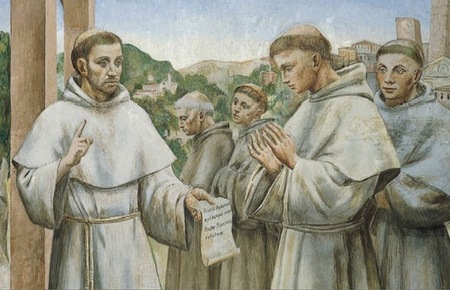
Six years ago at this time I was in my beloved ancestral town of Piedimonte–Matese for the procession of the relics of Sant’Antonio. This is what I wrote:
Organic Continuity of Popular Piety
Since my arrival here in Sepicciano di Piedimonte d’Alife (Piedimonte Matese) there has been a procession or feast nearly every day in one or more of the surrounding paesi. Popular Catholicism is alive and flourishing. There is, in fact, more organic continuity in the expression of popular piety than in the Sacred Liturgy. Whereas the Sacred Liturgy, easily manipulated and refashioned by the clergy, has become a devastated vineyard, popular piety remains in the hands of the people who are, instinctively attached to tradition and opposed to changes in the expression of their devotions.
Arrival of Saint Anthony’s Relics
Last evening the relics of Saint Anthony of Padova arrived in Piedimonte d’Alife. A large fragment of the Saint’s body was presented in a gilded bust of the saint, which I had the honour to carry, together with three Franciscan friars, through the streets of Piedimonte. All the priests present, including me, had the privilege of carrying in front of the gilded bust of Sant’Antonio another relic enshrined in a reliquary.
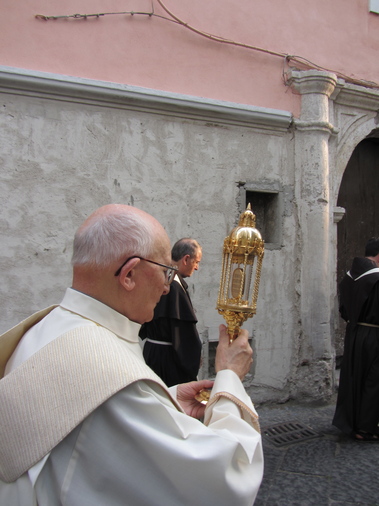 Procession Through the Streets
Procession Through the Streets
The entire town of Piedimonte turned out, in one way or another, to welcome Sant’Antonio. The arrival of the relics is understood to be a true visitation of the Saint himself, who comes in the Name of Jesus Christ, to distribute blessings, graces, and healings of soul and body. The municipal government was present, as were the military, the Police and Fire Departments, and various other representatives of civil life. Those who did not march in the procession, to the accompaniment of a marching band, made the sign of the Cross as the procession passed by. People of all ages responded with devotion to the passage of Sant’Antonio: little children dressed in Franciscan habits in honour of the miracle-working Saint; teenagers trying to look cool and, yet, moved nonetheless to cross themselves and gaze in wonder at the relics; young families; nonni (grandparents and great-grandparents); poor, rich, healthy, and sick. The passage of Sant’Antonio drew people out of their shops and houses and into the streets.
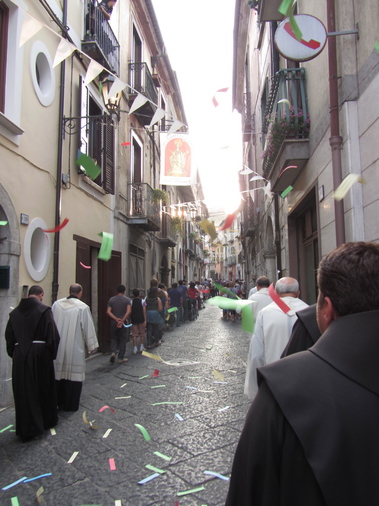 Floral Carpets Beneath Our Feet and Showers of Messages
Floral Carpets Beneath Our Feet and Showers of Messages
As we approached the destination of the procession, a large open piazza where an altar was erected for Holy Mass, there appeared under our feet thirteen “carpets” made of flower petals representing the lily, the symbol of Saint Anthony of Padua. From the balconies and open windows above our heads, people were showering handful after handful of strips coloured paper. On each piece of paper a sentence in honour of Saint Anthony was written. Two of these fell into my hands. I read them and slipped them into the pocket of my habit. On the first I read, Dottore delle anime guariscici, “Doctor of souls, heal us” — and on the second, Per Antonium ad Iesum, “Through Anthony to Jesus.”
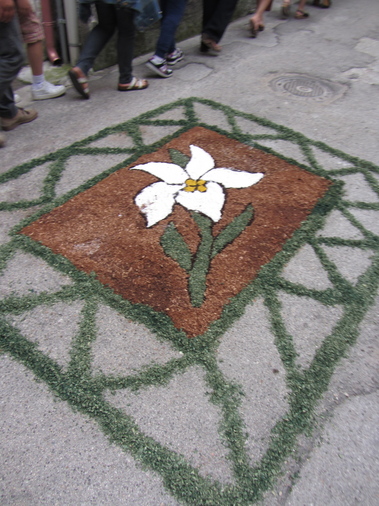 Carrying the Reliquary
Carrying the Reliquary
A third of the way through the procession Don Salvatore, the parish priest of Sepicciano slipped a stole over my head and gave me the reliquary to carry. I don’t know if it was by coincidence or design, but I carried the reliquary past the Monastero di San Benedetto, where the Benedictine Nuns of the Most Holy Sacrament keep a vigil of adoration and reparation before the Blessed Sacrament, day and night. I passed directly under the statue of Saint Benedict in his niche; surely he looked down upon me with pleasure, seeing in my hands the precious relics of Sant’Antonio, Doctor of the Church.
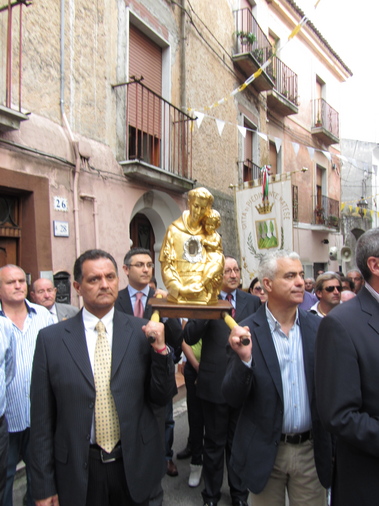 Holy Mass in the Piazza
Holy Mass in the Piazza
When we arrived at the piazza everything was ready for the celebration of Holy Mass for the Ascension of the Lord. The diocesan choir sang a polyphonic setting of the Ordinary in Latin. (The Propers, alas, were entirely omitted in favour of popular songs.) A Franciscan Father from the Sanctuary of Saint Anthony in Padova preaching a brilliant homily, presenting Sant’Antonio as a witness to the risen and ascended Lord. He mentioned a fact hithertofore unknown to me, that is, that when the body of Saint Anthony was removed from his tomb, physicians found his vocal cords perfectly intact, the very vocal chords with which he had preached the Gospel tirelessly until, at the age of 36, he died, consumed with holy zeal, saying, Video Dominum meum, “I see my Lord.”
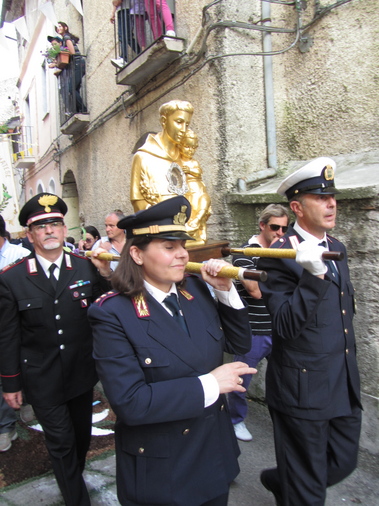 The Faith of the Ages
The Faith of the Ages
After Holy Mass, yet another procession formed, this time to transport the relics to the Cappella di Sant’Antonio, a small church in a neighbouring street, where they were to remain exposed to the veneration of the faithful who had organized themselves, according to various confraternities and parish societies, to pray before them through the night.
Catholicism is alive here. The Faith of the Apostles and the Saints flourishes among the people, rich and poor, young and old, educated and illiterate. Catholicism here is in the air one breathes and in the water one drinks. It is in the bread, the oil, and the wine on every table. Here one still finds a culture shaped by the cultus of the living God, who has revealed Himself merciful, powerful, and glorious in His Saints.

Thank you ,Father, for your continued reflections, some painful and others promising ! When I read your words, immediately came to mind this passage from Ezekiel….
Let us continue to pray for our shepherds, that above all, they would be filled with the Spirit of Holy Fear…and that they would recall it is indeed David who shall be prince among them, he who honored the Lord in poetic SONG !
Ezekiel
Chapter 34
Thus the word of the LORD came to me:
Son of man, prophesy against the shepherds of Israel, in these words prophesy to them (to the shepherds): Thus says the Lord GOD: Woe to the shepherds of Israel who have been pasturing themselves! Should not shepherds, rather, pasture sheep?
You have fed off their milk, worn their wool, and slaughtered the fatlings, but the sheep you have not pastured.
You did not strengthen the weak nor heal the sick nor bind up the injured. You did not bring back the strayed nor seek the lost, but you lorded it over them harshly and brutally.
So they were scattered for lack of a shepherd, and became food for all the wild beasts. My sheep were scattered
and wandered over all the mountains and high hills; my sheep were scattered over the whole earth, with no one to look after them or to search for them.
Therefore, shepherds, hear the word of the LORD:
As I live, says the Lord GOD, because my sheep have been given over to pillage, and because my sheep have become food for every wild beast, for lack of a shepherd; because my shepherds did not look after my sheep, but pastured themselves and did not pasture my sheep;
because of this, shepherds, hear the word of the LORD:
Thus says the Lord GOD: I swear I am coming against these shepherds. I will claim my sheep from them and put a stop to their shepherding my sheep so that they may no longer pasture themselves. I will save my sheep, that they may no longer be food for their mouths.
For thus says the Lord GOD: I myself will look after and tend my sheep.
As a shepherd tends his flock when he finds himself among his scattered sheep, so will I tend my sheep. I will rescue them from every place where they were scattered when it was cloudy and dark.
I will lead them out from among the peoples and gather them from the foreign lands; I will bring them back to their own country and pasture them upon the mountains of Israel (in the land’s ravines and all its inhabited places).
In good pastures will I pasture them, and on the mountain heights of Israel shall be their grazing ground. There they shall lie down on good grazing ground, and in rich pastures shall they be pastured on the mountains of Israel.
I myself will pasture my sheep; I myself will give them rest, says the Lord GOD.
The lost I will seek out, the strayed I will bring back, the injured I will bind up, the sick I will heal (but the sleek and the strong I will destroy), shepherding them rightly.
As for you, my sheep, says the Lord GOD, I will judge between one sheep and another, between rams and goats.
Was it not enough for you to graze on the best pasture, that you had to trample the rest of your pastures with your feet? Was it not enough for you to drink the clearest water, that you had to foul the remainder with your feet?
Thus my sheep had to graze on what your feet had trampled and drink what your feet had fouled.
Therefore thus says the Lord GOD: Now will I judge between the fat and the lean sheep.
Because you push with side and shoulder, and butt all the weak sheep with your horns until you have driven them out,
I will save my sheep so that they may no longer be despoiled, and I will judge between one sheep and another.
I will appoint one shepherd over them to pasture them, my servant David; he shall pasture them and be their shepherd.
I, the LORD, will be their God, and my servant David shall be prince among them. I, the LORD, have spoken.
I will make a covenant of peace with them, and rid the country of ravenous beasts, that they may dwell securely in the desert and sleep in the forests.
I will place them about my hill, sending rain in due season, rains that shall be a blessing to them.
The trees of the field shall bear their fruits, and the land its crops, and they shall dwell securely on their own soil. Thus they shall know that I am the LORD when I break the bonds of their yoke and free them from the power of those who enslaved them.
They shall no longer be despoiled by the nations or devoured by beasts of the earth, but shall dwell secure, with no one to frighten them.
I will prepare for them peaceful fields for planting; they shall no longer be carried off by famine in the land, or bear the reproaches of the nations.
Thus they shall know that I, the LORD, am their God, and they are my people, the house of Israel, says the Lord GOD.
(You, my sheep, you are the sheep of my pasture, and I am your God, says the Lord GOD.)
Thanks for this Father. It was very interesting and allows me to live vicariously through you.
“Catholicism here is in the air one breathes and in the water one drinks. It is in the bread, the oil, and the wine on every table. Here one still finds a culture shaped by the cultus of the living God, who has revealed Himself merciful, powerful, and glorious in His Saints.”
If enough of us pray and fast, we can make this a reality in the United States as well.
Veronica